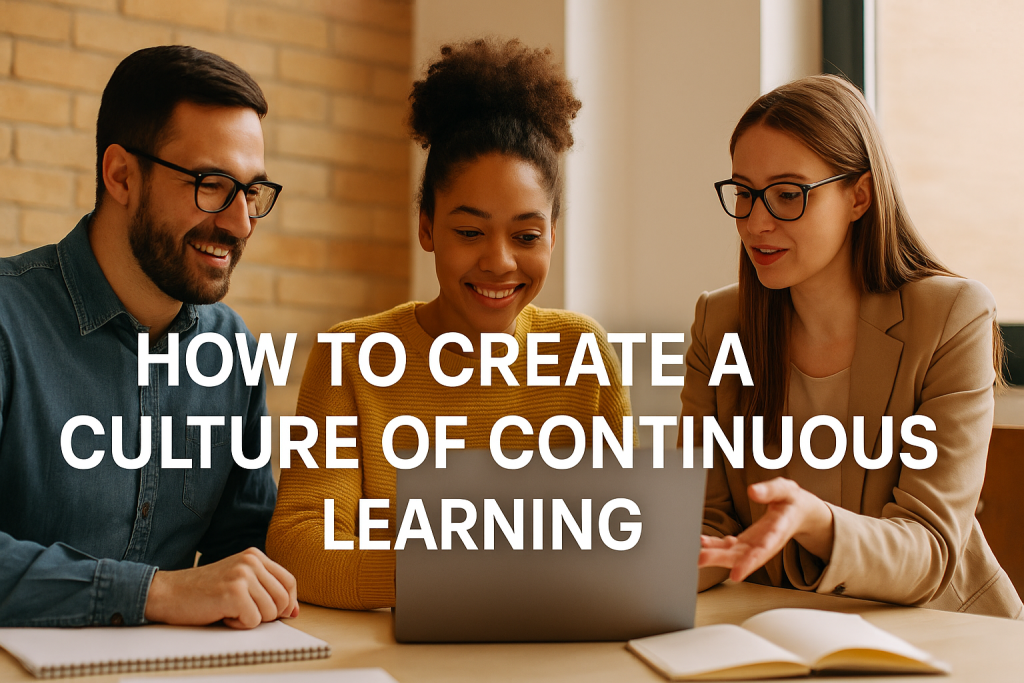In today’s rapidly changing work environment, the ability to adapt and learn continuously has become essential—not just for individuals, but for entire organizations. Building a culture of continuous learning is no longer a luxury; it’s a business imperative. Companies that prioritize learning report better employee engagement, faster innovation, and improved performance across all levels.
This article explores how businesses can foster a culture of continuous learning that is both practical and sustainable, with a focus on emerging trends such as microlearning, AI-driven training platforms, and the rise of internal talent marketplaces.

Why Continuous Learning Matters Now
The acceleration of digital transformation, automation, and evolving job roles have made continuous learning a strategic necessity. A recent report by McKinsey & Company highlighted that nearly 40% of workers will need to reskill by 2030 due to advancements in technology and shifting market demands. Organizations that fail to adapt risk losing relevance in both talent retention and market competitiveness.
Moreover, employees increasingly expect professional development opportunities. According to LinkedIn’s 2024 Workplace Learning Report, 94% of employees say they would stay longer at a company that invests in their learning and growth.
Key Elements of a Continuous Learning Culture
Creating a lasting culture of continuous learning involves more than offering a few online courses. It requires an ecosystem that supports curiosity, encourages feedback, and integrates learning into daily operations.
1. Leadership Buy-In and Role Modeling
Leadership plays a critical role in shaping workplace culture. When executives and managers prioritize their own learning and advocate for team development, it sets a powerful example. Leaders should actively engage in training, share what they’re learning, and allocate time for team development during work hours.
Action Tip: Host quarterly learning check-ins where team leads share key takeaways from recent learning initiatives and how they’ve applied them.
2. Embed Learning in Everyday Workflows
Learning should not feel like a separate or disruptive task. Companies that excel in building a culture of continuous learning integrate it into the flow of work. This includes tools like just-in-time training, internal knowledge hubs, and feedback loops that encourage reflection.
Emerging Trend: Platforms like Degreed and HowNow use AI to suggest bite-sized learning modules based on employees’ daily tasks and performance data.
3. Personalize Learning Paths
Employees want to learn, but not all in the same way. Personalized learning paths that align with individual goals and skill gaps are more engaging and effective. Use self-assessments, career aspirations, and performance data to curate relevant training content.
Action Tip: Offer tiered learning tracks—beginner, intermediate, and advanced—so that employees can progress at their own pace.
4. Promote Knowledge Sharing
Peer learning boosts collaboration and embeds knowledge deeper within teams. Encourage employees to teach others through mentorship programs, internal webinars, or simple Slack channels where team members can ask questions and share resources.
Action Tip: Start a “Learning Friday” tradition where a team member shares a 10-minute insight from a recent course or article.
5. Measure and Adjust
Creating a sustainable learning culture requires regular assessment. Metrics like course completion rates, employee satisfaction, performance improvement, and internal mobility can help you track effectiveness. Use these insights to refine programs and maintain alignment with company goals.
Current Trends Shaping Learning Cultures
As the workforce becomes more dynamic, learning strategies are evolving. Here are a few notable trends:
Microlearning on the Rise
Short, focused learning sessions—often under 10 minutes—are gaining popularity. Microlearning fits well into busy schedules and supports long-term knowledge retention.
AI and Learning Analytics
AI is revolutionizing corporate learning by offering personalized content recommendations, adaptive learning paths, and performance-based feedback. Tools like EdCast and LearnAmp use AI to analyze learning habits and suggest targeted improvements.
Internal Talent Marketplaces
Companies like Unilever and Schneider Electric are using internal talent marketplaces to let employees take on stretch projects, mentorship roles, or short-term gigs outside their department. This hands-on experience promotes learning through doing.
How to Implement a Continuous Learning Culture
Here’s a step-by-step guide for organizations ready to make learning an integral part of their culture:
Step 1: Audit Current Learning Practices
- What tools and platforms are currently being used?
- Are employees satisfied with the learning options?
- Where are the gaps?
Step 2: Set Clear Goals
Define what success looks like. Whether it’s increased engagement, faster onboarding, or more internal promotions, having tangible outcomes ensures alignment and commitment.
Step 3: Choose the Right Tools
Select platforms that are scalable, user-friendly, and aligned with your team’s needs. Prioritize integrations with existing tools like Slack, Teams, or your project management system.
Step 4: Empower Managers
Train managers to identify learning opportunities and support their teams. Offer toolkits, access to coaching resources, and space in team meetings for development check-ins.
Step 5: Incentivize and Recognize Learning
Incorporate learning into performance reviews, set development goals, and celebrate progress. Recognizing even small wins can go a long way in motivating teams.
Common Pitfalls to Avoid
- Overwhelming employees with too many options: Curate content based on relevance.
- Making learning mandatory without context: Focus on value and applicability.
- Ignoring feedback: Regularly survey employees and iterate based on their experience.
The Future of Learning Cultures
As hybrid work and AI continue to reshape industries, the companies that thrive will be those that treat learning not as a program, but as a mindset. By embedding a culture of continuous learning across all levels of the organization, businesses position themselves for resilience, innovation, and long-term success.
References
- McKinsey & Company (2021). The future of work after COVID-19. https://www.mckinsey.com
- LinkedIn Learning (2024). Workplace Learning Report. https://learning.linkedin.com
- Deloitte Insights (2023). Building a learning culture for the future of work. https://www2.deloitte.com
- Harvard Business Review (2022). How to Create a Culture of Learning. https://hbr.org
- World Economic Forum (2023). Jobs of Tomorrow: Mapping Opportunity in the New Economy. https://www.weforum.org






